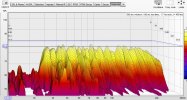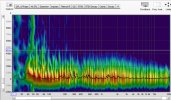mpasanthosh
Active Member
Agree with your facts , I have tried PEq trying to achieve a full flat response the system sounded dull and lifeless.My best advice to you is to first understand what needs an upgrade.
Let me elaborate
The vast majority of audiophiles never hear their currently owned system to their full potential. Why..? Because they don't have the means to understand or analyze what they really hear when sitting in their room at their listening position.
The solution to understand what you hear is a measurement microphone like a minidsp umik 1 and a computer. This is singlehandedly the best investment you can do if you are an Audiophile because it gives you the power to analyze what you are hearing at your listening spot. Every time you change a room or equipment you can measure how it affects the sound throughout your Audiophile life.
You can have several lac worth of a system in your room and have been listening to terrible sound for years before you sell it and move on to another system thinking "ive used the previous system for a long time and I've explored its performance". WRONG..!
There is a deceiving reason behind why this is happening which most companies will never tell you nor want you to know.
The measurements you see of a speaker you buy were taken in an anechoic chamber or on an infinite baffle if it is an individual driver.
The sound you are hearing in your suboptimal listening room which has asymmetric furniture, windows, doors is entirely different than the official specs.
let me give you a real-life example I encountered
take a good look at this system.
remember to keep that published frequency response of the speakers in mind.
View attachment 56258
View attachment 56259
ANECHOIC FREQUENCY RESPONSE OF AMATI FUTURA FROM STEREOPHILE WEBSITE
View attachment 56260
speakers are not visible in the first photo but it's situated in both sides which were SONUS FABER AMATI FUTURA.
one entire room was only dedicated to audio with an extensive amount of sound-absorbing panels and diffusers and bass traps symmetrically placed on all sides. there was no furniture except a listening chair and a table.
the price breakdown of equipment.
sonus faber amati futura - 27.1 lac INR
Genus Aries Cerat integrated amp- 15.5 lac INR
Genus kassandra dac- 20.7 lac INR
I'm not even gonna get into the streamer ,cd player , speaker cable ,interconnects, grounding box for speaker and all that. it was priced at a similar ratio. but you get the idea.
so looking at it, any audiophile would consider this as one of the top-tier most desirable audio systems you can have and expect the resultant sound to be nothing short of perfect. Right..?
you wanna see what we saw when we measured it with a measurement mic at the listening spot..? keep your tissue papers ready to wipe off the tears.
View attachment 56261
WHAT DO YOU THINK...?
well as they say the truth is always ugly.
go and compared the in-room response to the published response. are they any similar..?
so this was the sound signature he was getting from a multimillion rupee system at his listening spot. A sound output filled with nonlinearities, resonances, cancelations, and reverberations. do you think this will sound good to anyone regardless of being subjectivist or objectivist...?
If you think "oh this is not the case in my room and that guy didn't know how to set up his system", then by most probability you are wrong because sound waves are not something under your control and it interacts with everything in the room and can be extremely unpredictable. I'm telling this from the experience of measuring a lot of seemingly perfect dedicated audio rooms like this one here.
it made me wonder what is the use of all this running behind upgrades if you never qualitatively measured and understood what you were hearing all this while.
so readers what did you learn from this.?
you can keep running behind upgrades all your life and never be satisfied unless you scientifically understand what you are hearing.
there is always a lot more unexplored potential in your current setup waiting to be discovered like a sunken ship filled with gold.
once you have that power to measure you can correct this sound by passive methods like positioning the speakers or positioning furniture, carpets, and remeasuring to assure that what you hear is acceptable. the best part is that this costs close to nothing compared to what people shell out for upgrades. The only cost involved is the price of the mic.
So my advice to you is to keep your amplifier for now.
Yes, your speakers might need an upgrade as bookshelves are generally limited for the bass they can produce. so get or build a new set of speakers which can produce sound in a linear manner.
then get a measurement mic and measure what you hear at your listening spot. then experiment with speaker positions and furniture to get a reasonable sound signature.
if you want to further fine-tune the output do room correction using a parametric EQ on a windows computer (computer has to be the source always) OR get a minidsp room correction module and correct using it if your source is a cd or vinyl.
Now it's time for you to analyze the information and decide your strategy.
I wish you all the best.
Happy listening
Measuring and optimizing a system will help for sure with additional processing, personally any peak of dip beyond 3db is better left untouched in DSP. Too much processing makes it sterile and some how I don't find it comfortable, I use 32 band PEq specific to every single speaker with varied Q Factor derived from REW and each driver has its own channel for amplification, running with active crossovers.
Though I would not make it a goal to achieve manufacturers frequency response in my listening room.
Would love it the way I like to listen music to.
Back in those people used equalisers to perform EQ correction. Some time it is the content that is dull and lifeless and you voluntarily use EQ to make up for it .
The right size speaker for the right room size help a lot.
My target would be to not meet a manufactures frequency response, but to indeed have it adjusted to my personal taste, preference and liking. I have heard full flat response and tried various house curves never liked it much.
Used processing to a minimal extent and it does wonders.
REW will aid in proper speaker positing, treatment etc and it is worthwhile investing in UMIK-1.



